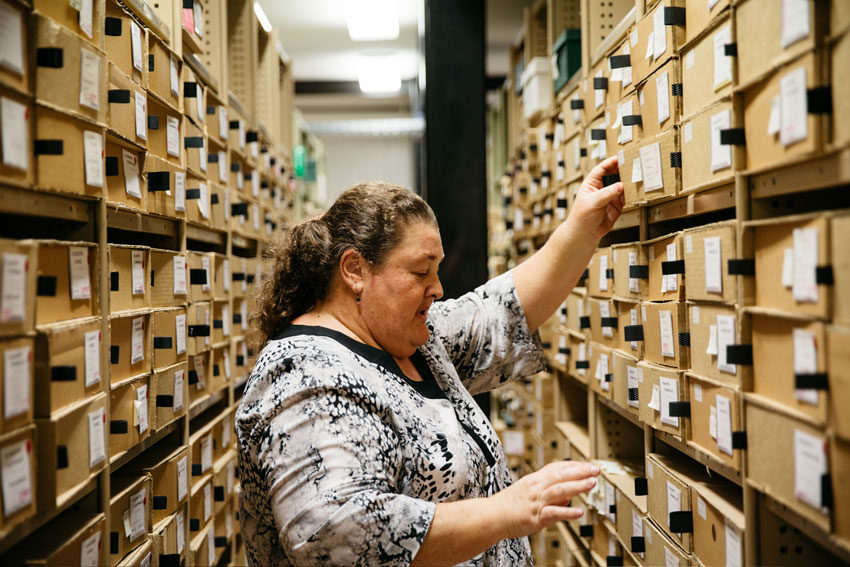Inside the bunker safeguarding South Australia's rare plants and botanical history

A converted heritage tram barn protects a vast collection of plant specimens from around South Australia and the world.
Inside the State Herbarium of South Australia – located on Hackney Road on the eastern edge of the Botanic Gardens – large storerooms lined with rows of cabinets occupy a side of the building usually off-limits to the public
At the turn of a wheel, one of these giant containers opens. Inside is a cabinet of curiosities, in which you might come across the plants botanist Robert Brown collected during Flinders’ expedition of 1802, or a piece of 350-year-old wood ornately engraved with details of its origins at Oxford University’s Sheldonian Theatre, or a leaf from a New Zealand silver fern from the 1770s preserved with such care that it could plausibly have been plucked from the forest floor mere months ago.
During South Australian History Festival Open Doors weekend, from Saturday, April 27 to Monday, April 29, the Herbarium will be hosting tours.

The Herbarium holds a second interest for local history buffs: the original building, Tram Barn A, was constructed in 1909 as part of the infrastructure for the state’s new electric tram line. It retains many original industrial features, including the state’s first automatic sprinklers.
“It became derelict after the tramlines closed, and, for many years, it was a bit of an eyesore,” says chief botanist Michelle Waycott, who will be taking the Open Doors tours. “It was remodelled as the new home for the Herbarium in the late 1990s.”
Waycott will explore the building’s unique history during these tours, as well as showing guests parts of the Herbarium’s vast collection that few get to see.
“We have over one million specimens and counting,” she says as she leads The Adelaide Review past a crowded display cabinet and a cupboard stacked high with acid-free, museum-grade cardboard. “Space, you can imagine, is an issue.

“Botanists don’t actually have a lot of time to go around collecting plants, so a lot of our samples come from citizens,” she says. “Each year we get about 10,000 new specimens.”
When a new specimen comes in, it spends a few weeks in a giant freezer in order to kill off any pests that might still be attached to the cutting. Most specimens are then mounted on archival paper, using a simple method water press method. The results can be enchanting. Some of the most magnificent pressings – large, tangled algae, tiny, flimsy flowers – are framed and displayed on the walls.
Sometimes, when a botanist decides to preserve a plant in its three-dimensionality, it is bottled in a pickling concentrate. When you enter the room containing these ‘wet collections’, a strong whiff of alcohol hits your nostrils.

Among the thousands of jars in this room, one shelf is occupied by the country’s orchids, suspended delicately in their vessels, only slightly browned by the years spent in the pickling liquid. Next to the orchids are jars containing some of the state’s algae, which are Waycott’s field of expertise.
“Here are some of my babies,” she says, carefully selecting a jar that contains a wispy specimen. “I’m currently doing some work along the Coorong. This is a little plant that lives there that we’re losing, which means the birds don’t have enough food.”
Herbariums play a unique cultural role that many of us know little about. On one hand, they are collectors and guardians of our natural history, including what remains of extinct plants. On the other hand, they are places of discovery and innovation where research in fields as disparate as medicine and climate change occurs.
In recent years, as DNA testing has continued to advance, the Herbarium has been extracting samples from much older plant materials.

“We’ve taken a sample from a plant collected as far back as 1891, and we are routinely getting material from 50-to 80-year-old specimens. It’s fantastic because it means we are starting to get a snapshot in time of certain plants.”
Digital technologies have also changed the way herbariums around the world run. One room is occupied by a giant camera that takes incredibly detailed flat lay pictures of the specimens – almost as good as a microscope – that can be sent to botanists and researchers around the world. And yet, despite such advances in technology, botanical artists are still commissioned to draw plants for the Herbarium and Botanic Gardens’ quarterly journal. The originals of these drawings are carefully stored away in one of the Herbariums many cabinets.
“Photographs are great, but an illustrator can show all the important aspects of the plant within one illustration,” Waycott says.
Spending an hour in the Herbarium has been like entering a time-warp of sorts – a place where the past, present and future live side-by-side.
To book a tour of the South Australian State Herbarium visit botanicgardens.sa.gov.au/whats-on.
Details of all buildings taking part in the Open Doors weekend can be found at historyfestival.sa.gov.au

State Herbarium (Photo: Sia Duff)